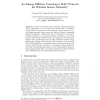Free Online Productivity Tools
i2Speak
i2Symbol
i2OCR
iTex2Img
iWeb2Print
iWeb2Shot
i2Type
iPdf2Split
iPdf2Merge
i2Bopomofo
i2Arabic
i2Style
i2Image
i2PDF
iLatex2Rtf
Sci2ools
APWEB
2006
Springer
2006
Springer
An Energy Efficient Cross-Layer MAC Protocol for Wireless Sensor Networks
In the area of wireless sensor networks, achieving minimum energy consumption is a very important research issue. A number of energy efficient protocols have been proposed, mostly based on a layered design approach, which means that they are focused on designing optimal strategies for "single" layer only. In this paper, we take an alternative approach i.e., a cross-layer design, and present a new MAC protocol named MAC-CROSS. In this new approach, the interactions between MAC and Routing layers are fully exploited to achieve energy efficiency for wireless sensor networks. More precisely, in the proposed MAC-CROSS algorithm, routing information at the network layer is utilized for the MAC layer such that it can maximize a sleep duration of each node. Through implementation on a Mica Mote platform and simulation study using the NS-2, we evaluate a performance of the presented MAC-CROSS and prove its substantial performance gains.
APWEB 2006 | Internet Technology | Layered Design Approach | Minimum Energy Consumption | Wireless Sensor Networks |
| Added | 20 Aug 2010 |
| Updated | 20 Aug 2010 |
| Type | Conference |
| Year | 2006 |
| Where | APWEB |
| Authors | Changsu Suh, Young-Bae Ko, Dong-Min Son |
Comments (0)

